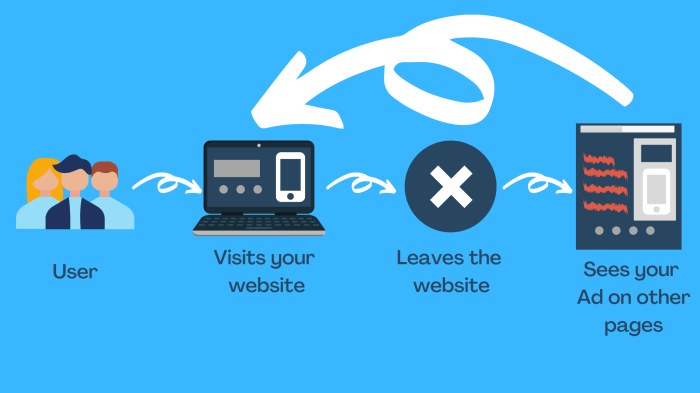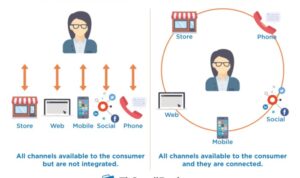Retargeting Ads Guide kicks off this journey into the world of targeted advertising, where businesses can reach their audience with precision and impact. From understanding the basics to optimizing campaigns, this guide has everything you need to elevate your marketing game.
Overview of Retargeting Ads
Retargeting ads are a powerful digital marketing strategy that allows businesses to target users who have previously visited their website or interacted with their brand online. These ads work by tracking user behavior through cookies and displaying targeted ads to those users as they browse other websites or social media platforms.
Benefits of Using Retargeting Ads for Businesses
- Increased Conversions: By targeting users who have already shown interest in your brand, retargeting ads can lead to higher conversion rates and ultimately drive more sales.
- Improved Brand Awareness: Retargeting ads keep your brand top of mind for users, even after they have left your website, helping to increase brand recall and recognition.
- Cost-Effective Advertising: Retargeting ads are generally more cost-effective than traditional advertising methods, as they target a specific audience that is more likely to convert.
- Precise Targeting: Retargeting ads allow businesses to segment their audience based on their behavior on the website, enabling more personalized and targeted advertising campaigns.
Examples of Successful Retargeting Ad Campaigns
Amazon: Amazon uses retargeting ads to show users products they viewed or added to their cart but didn’t purchase, increasing the likelihood of completing the purchase.
Netflix: Netflix uses retargeting ads to remind users about new releases or shows they might be interested in based on their viewing history, keeping users engaged with the platform.
Types of Retargeting Ads
When it comes to retargeting ads, there are different types that marketers can utilize to reach their target audience more effectively. Let’s dive into the various types of retargeting ads to understand how each one works.
Pixel-Based vs. List-Based Retargeting
Pixel-based retargeting involves placing a tracking pixel on your website, which then tracks the behavior of your site visitors. This allows you to display targeted ads to those visitors as they browse other websites or social media platforms. On the other hand, list-based retargeting involves uploading a list of contacts or customers to a retargeting platform, which then targets ads to those specific individuals based on their contact information.
Dynamic Retargeting Ads
Dynamic retargeting ads are personalized ads that are automatically generated based on the products or services that a user has previously viewed on your website. These ads are highly relevant to the user’s interests and behavior, making them more likely to convert. By showing users the exact products they have shown interest in, dynamic retargeting ads can significantly increase conversion rates.
Email Retargeting
Email retargeting involves sending targeted emails to individuals who have visited your website but did not make a purchase or complete a desired action. By sending personalized follow-up emails with relevant content or offers, you can re-engage these visitors and encourage them to return to your site and complete the desired action. Email retargeting is a powerful way to nurture leads and drive conversions through targeted communication.
Setting up Retargeting Campaigns
To start creating retargeting campaigns, you need to follow a step-by-step process that involves setting up your ads, defining your target audience, and optimizing your campaigns for better results.
Creating Retargeting Ads, Retargeting Ads Guide
- Choose a retargeting platform such as Google Ads or Facebook Ads.
- Create a new campaign and select the retargeting option.
- Set your campaign objectives and budget.
- Create engaging ad creatives that resonate with your audience.
- Set up tracking pixels on your website to track user behavior.
Setting up Retargeting Audiences
- Define your retargeting audience based on their behavior on your website.
- Create custom audience segments for specific products or pages they visited.
- Exclude audiences who have already converted to avoid wasting ad spend.
- Use lookalike audiences to reach new potential customers similar to your existing ones.
Optimizing Retargeting Campaigns
- Monitor your campaign performance regularly and make adjustments as needed.
- A/B test different ad creatives, messaging, and targeting options to find what works best.
- Use frequency capping to prevent ad fatigue and annoyance for users.
- Experiment with different ad formats such as carousel ads, video ads, or dynamic ads.
Retargeting Ad Platforms

When it comes to running retargeting ads, there are several popular platforms to choose from, each with its own unique features and targeting options. Let’s take a look at some of the top platforms like Google Ads, Facebook, and AdRoll, and how they stack up against each other.
Google Ads
Google Ads, formerly known as Google AdWords, is one of the most widely used platforms for running retargeting ads. With Google Ads, you have access to a wide range of targeting options, including demographics, interests, and s. This platform is great for reaching a large audience and driving conversions.
Facebook is another powerful platform for running retargeting ads, especially considering its massive user base. With Facebook Ads, you can target users based on their behavior, interests, and demographics. The platform also offers features like lookalike audiences, which can help you expand your reach to new potential customers.
AdRoll
AdRoll is a popular choice for retargeting ads, offering a wide range of targeting options and ad formats. With AdRoll, you can retarget users across multiple channels, including social media, email, and the web. The platform also provides detailed analytics to help you track the performance of your campaigns.
Choosing the Right Platform
When it comes to choosing the right platform for your retargeting campaigns, consider factors like your target audience, budget, and campaign goals. Each platform offers unique features and targeting options, so it’s important to choose one that aligns with your specific needs and objectives. Conducting A/B tests across different platforms can also help you determine which one delivers the best results for your business.
Measuring Retargeting Ad Performance: Retargeting Ads Guide

When it comes to measuring the success of your retargeting ads, there are several key metrics you should track to ensure you are reaching your goals. From click-through rates to conversion rates, these metrics can provide valuable insights into the effectiveness of your campaigns.
Key Metrics to Track
- Click-Through Rate (CTR): This metric measures the percentage of people who clicked on your retargeting ad after seeing it. A high CTR indicates that your ad is engaging and relevant to your target audience.
- Conversion Rate: The conversion rate tracks the percentage of users who completed a desired action, such as making a purchase or signing up for a newsletter, after clicking on your retargeting ad. This metric directly correlates to the success of your campaign in driving conversions.
- Cost Per Acquisition (CPA): This metric calculates the average cost of acquiring a new customer through your retargeting ads. By monitoring your CPA, you can optimize your ad spend and improve the overall efficiency of your campaigns.
A/B Testing Strategies
- Test Different Ad Creatives: Experiment with variations in ad copy, images, and calls-to-action to see which combinations resonate best with your audience.
- Try Different Audience Segments: Divide your audience into segments based on demographics, behaviors, or interests, and test different retargeting ads for each group to determine which performs the best.
- Adjust Frequency and Timing: Test different frequencies and times of day for showing your retargeting ads to find the optimal schedule for reaching your audience.
Interpreting Data for Improvement
- Analyze Performance Trends: Look for patterns in your data to identify what is working well and what areas need improvement in your retargeting campaigns.
- Optimize Ad Creative: Use insights from your data to refine your ad creatives, messaging, and visuals to better resonate with your target audience.
- Refine Audience Targeting: Adjust your audience targeting parameters based on data analysis to reach the most qualified leads and improve campaign performance.












